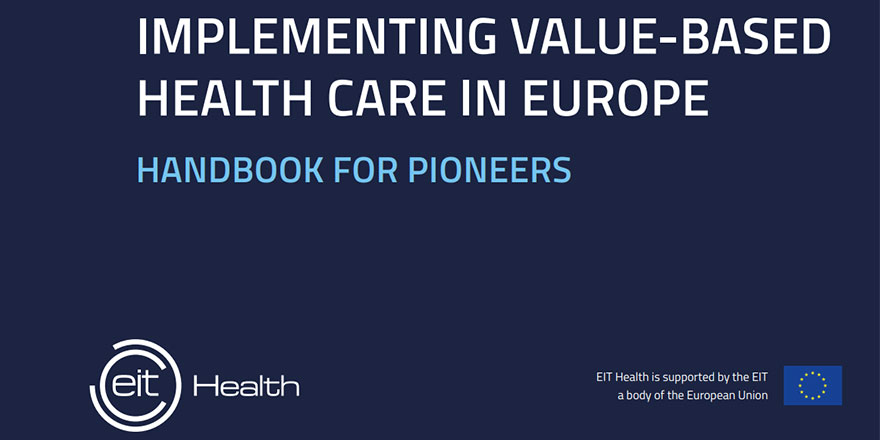EIT Health launches guidance on Value-Based Health Care

Framework shows healthcare providers how to improve patient outcomes and reduce waste.
EIT Health has launched a new framework for achieving Value-Based Health Care (VBHC) to improve patient outcomes and reduce waste of healthcare resources. Designed with insights from established pioneers in the field and laid out in a practical handbook, the framework describes key steps healthcare providers can take to fully realise the opportunity presented by VBHC.
Unlike traditional volume-based healthcare provision, modelled on fees for-products or services, VBHC provides a methodology for measurable healthcare outcomes that make the biggest difference to patients, while driving cost efficiencies within health services. The World Health Organization (WHO) and The Organisation for Economic Co-operation and Development (OECD) estimate that around 30% of resources currently spent on healthcare are wasted on avoidable complications, unnecessary treatments or administrative inefficiencies.
Tackling this waste head on, the publication from EIT Health aims to kick-start change towards measurable value, in order to support more sustainable models for healthcare.
The new EIT Health publication “Implementing Value-Based Health Care: Handbook for Pioneers”, includes an “Implementation Matrix” with a clear and structured framework for healthcare providers to follow. The Matrix details five key steps to help healthcare providers activate and accelerate VBHC: 1) recording; 2) comparing; 3) rewarding; 4) improving; and 5) partnering. It outlines how to measure and maximise the outcomes that matter to patients, and addresses the main challenges, such as lack of standardised outcome data and resistance to change.
Jan-Philipp Beck, CEO of EIT Health, explains the need for this work: “In recent years, there has been a growing interest in VBHC in the health community in Europe; however the focus has been on why it is the way forward, rather than how we effectively implement such a change. This is why we created this framework, to provide an in-depth guide on how health care managers and practitioners can orient efforts and resources towards necessary transformation. Currently, many of Europe’s health care systems measure the wrong things, which can lead to inefficiencies in cost, time and resources, not to mention the impact on the patient. Metrics focus on volume rather than patient outcomes, and this is simply unsustainable for health care systems. At EIT Health, we are uniquely placed to connect successful pioneers in the field with those just starting out, and to share tools and best practices to help measure outcomes to drive this cultural shift within Europe’s health care systems.”
Esteemed experts engaged by EIT Health Think Tank
Development of this EIT Health handbook has been directed by Professor Gregory Katz of the University Paris School of Medicine and achieved in collaboration with esteemed experts from across leading European organisations. The new framework is based on several VBHC case studies from some of Europe’s leading healthcare providers, including: Uppsala Academic Hospital, which reduced the number of unnecessary ambulance dispatches by 17%; Basel University Hospital, which improved the median time from stoke symptom to treatment onset by 14%; and NHS Wales, which identified that in 19% of cases, high-cost cataract surgery had no real impact on a patient’s activity limitations in daily life.
According to Professor Gregory Katz: “Today in Europe, VBHC pioneers are choosing to take bold action to measure, compare and improve patient outcomes. This momentum is mainly building from the bottom up, through entrepreneurial initiatives. As care results vary tremendously between therapeutic approaches and medical teams, transparent outcome benchmarks enable the detection of medical innovations and the reduction of inappropriate care. There are good reasons to be impatient for improving health care through VBHC, but there are also reasons to be humble. VBHC is still in its infancy, and successful implementation takes time. Becoming a VBHC early adopter opens the opportunity to learn proactively and spearhead high-value care.”
The handbook was commissioned by EIT Health under its Think Tank thought leadership forum, which explores the most pressing topics for the health of Europe and its citizens. The EIT Health Think Tank brings healthcare leaders together, across disciplines and borders, to prepare the ground for life-changing innovation and identify the next opportunity for a transformation in how healthcare is delivered. The launch of the handbook marks the first in a series of activities being launched by EIT Health that are designed to support a step-change in the provision of healthcare and to integrate VBHC as the new norm across Europe.

 Share this page
Share this page


